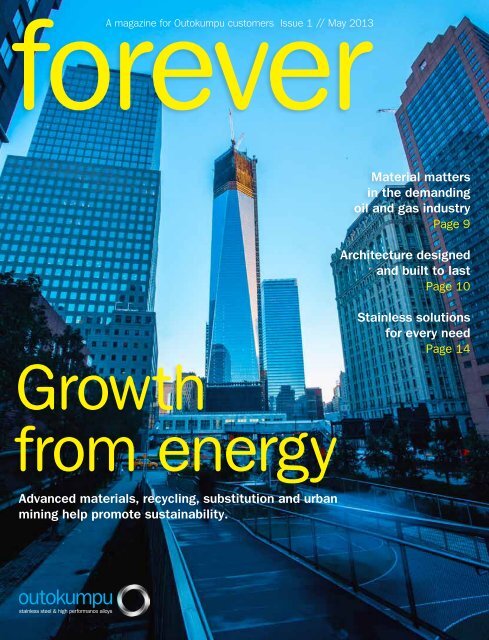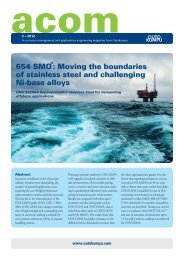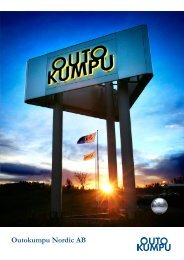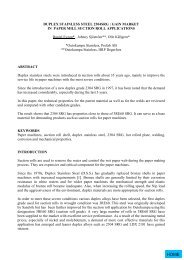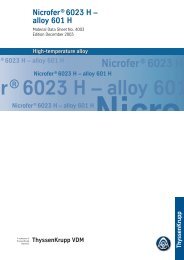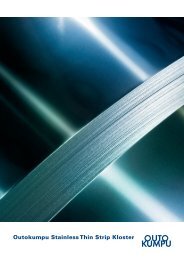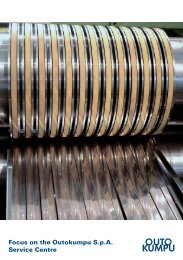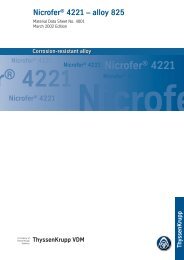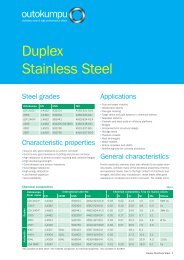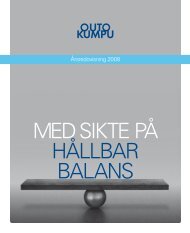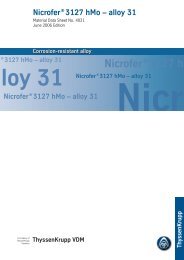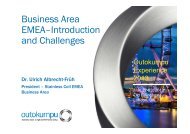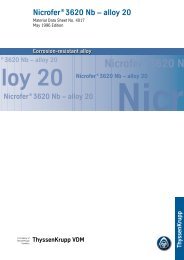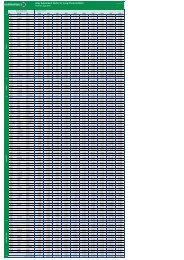Forever issue 1/2013 - Outokumpu
Forever issue 1/2013 - Outokumpu
Forever issue 1/2013 - Outokumpu
You also want an ePaper? Increase the reach of your titles
YUMPU automatically turns print PDFs into web optimized ePapers that Google loves.
forever<br />
A magazine <strong>Outokumpu</strong> customers Issue 1 // May <strong>2013</strong><br />
Material matters<br />
in the demanding<br />
oil and gas industry<br />
Page 9<br />
Architecture designed<br />
and built to last<br />
Page 10<br />
Growth<br />
Stainless solutions<br />
for every need<br />
Page 14<br />
from energy<br />
Advanced materials, recycling, substitution and urban<br />
mining help promote sustainability.
Ò editorial<br />
<strong>Forever</strong><br />
committed<br />
At the turn of the year, we merged <strong>Outokumpu</strong> and<br />
Inoxum, the stainless steel arm of ThyssenKrupp. This new<br />
industry leader brings together a dual legacy of 100 years: a<br />
legacy that stands behind the invention of stainless steel and<br />
other advanced materials. Both companies have earned a<br />
strong reputation for reliability, quality and technical expertise<br />
among customers.<br />
As a new company, we wanted to redefine ourselves in<br />
a way that respects our proud history while transforming us<br />
into a true industry leader. In addition to the wide range of<br />
high-quality products, we believe we have the technical expertise<br />
and customer-orientation to provide optimal materials for<br />
building a more sustainable world.<br />
"The world deserves<br />
innovations that can stand<br />
the test of time."<br />
Our vision – “a world that lasts forever” – perfectly<br />
captures our belief that the world deserves innovations that<br />
can stand the test of time and are ready to be born again<br />
at the end of their life cycle. And it is our mission to be the<br />
company that creates advanced materials that are efficient,<br />
long lasting and recyclable.<br />
We want <strong>Outokumpu</strong> to stand for what is important to our<br />
customers. We want to be the supplier of choice, providing<br />
advanced materials that can make our customers become<br />
more competitive, and help build a world that is designed to<br />
last forever.<br />
I hope that you find this magazine interesting and useful in<br />
discovering how <strong>Outokumpu</strong> is helping different companies<br />
with their materials solutions needs.<br />
Mika Seitovirta<br />
CEO<br />
<strong>Outokumpu</strong><br />
2 <strong>Forever</strong> 01|13
16<br />
Ò contents<br />
Staying in<br />
ship shape<br />
Industry veteran Joe Turner reveals how the marine industry has<br />
benefited from <strong>Outokumpu</strong> expertise for over half a century.<br />
4<br />
18<br />
2 Editorial<br />
The new <strong>Outokumpu</strong> brings together<br />
a dual legacy of 100 years.<br />
4 Megatrend<br />
When it comes to energy,<br />
Dr. Friedbert Pflüger advises against<br />
short-sighted thinking.<br />
9 Dialogue<br />
Erling Ryengen and Peder Claesson<br />
discuss material selection.<br />
10 Built to last<br />
How do sustainability and<br />
architecture intertwine? Catherine<br />
Houska answers.<br />
13 Profile<br />
Peter Samuelsson on life cycle.<br />
14 In the spotlight<br />
<strong>Outokumpu</strong>’s sustainable solutions<br />
serve a wide spectrum of customers.<br />
16 In the spotlight: case<br />
The marine industry continues to<br />
benefit from <strong>Outokumpu</strong> expertise.<br />
18 Steel cold facts<br />
Stainless steel in action<br />
around the world.<br />
20 Back cover<br />
Where to meet us next.<br />
Sneak peek<br />
Mika Toikka,<br />
Head of <strong>Outokumpu</strong><br />
Marketing says:<br />
“Excitement and<br />
curiosity – that sums<br />
up my feelings about<br />
the journey we started<br />
earlier this year. As<br />
a global leader in<br />
advanced materials, a<br />
bold vision was needed.<br />
When we asked our<br />
customers, 92 percent<br />
said <strong>Outokumpu</strong>’s new<br />
story is appropriate for<br />
our industry. I hope<br />
this magazine triggers<br />
dialogue that helps us<br />
steer our ship on the<br />
right course.”<br />
<strong>Forever</strong><br />
<strong>Outokumpu</strong>’s customer magazine. Published two times a year.<br />
<strong>Outokumpu</strong> Oyj, Riihitontuntie 7B, 02201 Espoo, Finland<br />
Editor-in-Chief Mika Toikka Managing Editor Anne Myllykoski<br />
Editorial production Sanoma Custom Media Graphic design Tuukka Lindqvist<br />
On the cover: One World Trade Center (previously known as Freedom Tower) in New York.<br />
PEFC/02-31-175<br />
01|13 <strong>Forever</strong> 3
Ò Megatrend<br />
4 <strong>Forever</strong> 01|13
New energy<br />
rules<br />
“Sustainable<br />
growth depends on our ability to deliver<br />
safe and reliable energy at an affordable price while<br />
keeping detrimental environmental impacts to a<br />
minimum,” says Professor Friedbert Pflüger.<br />
✎ Jorma Leppänen A Markus Henttonen<br />
01|13 <strong>Forever</strong> 5
Ò Megatrend<br />
Europe has made tremendous progress in deploying<br />
sustainable sources of energy in a relatively short period<br />
of time. Friedbert Pflüger, Professor and Director of<br />
the European Centre for Energy and Resource Security<br />
at King’s College London, emphasizes the importance of<br />
a strong economy:<br />
”Without a robust industrial and manufacturing base, we will<br />
lack the financial means to continue to provide the incentives<br />
necessary for the further deployment of renewable energy systems<br />
and more energy-efficient technologies. These are prerequisites for<br />
sustainable growth.”<br />
According to Dr. Pflüger, technologies like carbon capture and<br />
storage (CCS), effective storage technologies for renewable energy,<br />
and the substitution of oil with natural gas or hydrogen in the<br />
transport sector would go a long way in meeting sustainability<br />
challenges.<br />
”Now we must ensure that the investment climate necessary for<br />
further developing these and other technologies is not hampered<br />
by short-sighted or ineffective policies.”<br />
Industries in the driver’s seat<br />
Dr. Pflüger is worried that the energy market is gradually becoming<br />
"A growing world population,<br />
urbanization and higher<br />
living standards are clearly<br />
pushing up the demand for<br />
renewable energy."<br />
- Dr. Friedbert Pflüger<br />
fraught with regulatory burdens and inefficiency. Also the relatively<br />
high energy prices and strict carbon mitigation policies make<br />
it increasingly difficult for European companies to compete internationally,<br />
he says.<br />
”We are already witnessing the birthing pains of an exodus of<br />
industry, especially energy-intensive industries, from Europe to<br />
more favorable markets such as the US.”<br />
Dr. Pflüger sees that further improvements in efficiency through<br />
advanced materials, recycling, substitution and urban mining can<br />
still contribute significantly to the sustainability efforts of energyintensive<br />
industries.<br />
”These industries may also have to explore strategies that focus<br />
on securing natural resources abroad. For instance, it would be<br />
prudent for them to pool resources together to enhance global<br />
competitiveness, and to pursue strategic, long term cooperation on<br />
the industry level.”<br />
Growing need for energy<br />
The International Energy Agency (IEA) estimates that by 2030,<br />
coal, oil and natural gas will still account for nearly 80 percent<br />
of the world’s primary energy mix. Further expansion of nuclear<br />
capacity, especially in non-OECD countries like China, Russia and<br />
India, is expected to continue.<br />
”The utilization of hydraulic fracturing to tap unconventional<br />
shale gas, shale oil and tight oil has tremendously boosted<br />
the world’s proven oil and gas reserves over the past decade,” Dr.<br />
Pflüger says.<br />
The global drive toward sustainable and clean energy technologies<br />
is predominantly spurred by the desire to mitigate climate<br />
change by reducing CO 2<br />
emissions and to achieve a higher degree<br />
of energy security and self-sufficiency.<br />
”While these two factors are still key drivers, a growing world<br />
population, urbanization and higher living standards are also<br />
clearly pushing up the demand for renewable energy." •<br />
6 <strong>Forever</strong> 01|13
Prof. Dr. Friedbert<br />
Pflüger is the<br />
Director of the<br />
European Centre<br />
for Energy and<br />
Resource Security<br />
(EUCERS) at King's<br />
College London.<br />
01|13 <strong>Forever</strong> 7
Ò Megatrend<br />
Energy solutions for the future<br />
Applications based on <strong>Outokumpu</strong>’s wide product range enhance safety and<br />
efficiency in all forms of energy production.<br />
The megatrends of population growth and rising energy<br />
consumption combined with limited resources give direction<br />
to <strong>Outokumpu</strong>’s business.<br />
“We have been offering products and applications for the<br />
energy industry for decades, and it is a great opportunity for us<br />
to be able to further develop our business based on our proven<br />
strengths,” says Bernd Beckers, Duplex Product Manager at<br />
<strong>Outokumpu</strong>.<br />
<strong>Outokumpu</strong> caters to the current energy trends with a wide<br />
variety of advanced materials in all parts of the value chain,<br />
be it drilling, transporting, producing or transmitting.<br />
“Our products are used, for example, by oil exploration and<br />
production companies deep under the ocean floor. Solar power<br />
plants use our products for efficiency. Our tailor-made, highly<br />
sophisticated stainless steels and alloys are applied in a multinational<br />
fusion reactor project.”<br />
<strong>Outokumpu</strong>’s ability to find the best and most cost-efficient<br />
solutions together with the customer is based on the wide range<br />
of products, from martensitic grades with low corrosion resistance<br />
up to highly sophisticated materials like nickel alloys with very<br />
high corrosion resistance.<br />
“For example, in different parts of a power plant there are<br />
different kinds of work environments and local operating conditions.<br />
We help our customers choose the right kind of grades for different<br />
components of the unit and create an economical design.”<br />
<strong>Outokumpu</strong> develops and supplies materials for a growing<br />
number of alternative energy producers, but most of the global<br />
energy production will be based on coal along with oil and gas in the<br />
coming decades. New nuclear power plants will also be built in many<br />
parts of the world.<br />
“We supply materials for new nuclear power plants: for accumulator<br />
tanks, steam separator plates, heat exchangers and<br />
pool liners, for example. On the other hand, we offer solutions for<br />
handling and storing used fuel rods and contaminated materials.”<br />
“For fossil fuel power generation we offer materials suitable for<br />
boiler equipment and, for instance, flue gas desulphurization units.<br />
In those we can offer a very competitive solution for our customers<br />
by an economical design in which both alloys and stainless steel<br />
are used.”<br />
<strong>Outokumpu</strong><br />
meets the<br />
energy trends<br />
with a wide<br />
variety of<br />
different<br />
materials and<br />
applications in<br />
all parts of the<br />
value chain.<br />
Read more<br />
about<br />
<strong>Outokumpu</strong>'s<br />
successful<br />
customer<br />
cases on pages<br />
18–19.<br />
8 <strong>Forever</strong> 01|13
Material matters<br />
Ò DIALOGUE<br />
The complex and crucial material selection process lays the groundwork for<br />
creating sustainable solutions in any field. Principal Engineer Erling Ryengen of Aker<br />
Solutions and <strong>Outokumpu</strong>’s Product Manager Peder Claesson discuss the ins and outs of<br />
material selection for the demanding oil and gas industry.<br />
✎ Randel Wells A Aker Solutions and <strong>Outokumpu</strong><br />
RYENGEN: When we get an inquiry from an oil and gas company, we<br />
usually receive a design basis for the installation. Local and international<br />
standards provide further criteria. The actual requirements are<br />
specified in-house, and we have a sizable team for this purpose, as<br />
do most of our oil and gas customers as well. The criteria for material<br />
selection start with factors such as service conditions – contact with<br />
hydrocarbon, air and sea water. We then look at temperature, carbon<br />
dioxide content and the presence of hydrogen sulphide. For offshore<br />
installations, weight may play an important, but often underestimated,<br />
role, driving the material selection towards the use of high strength<br />
stainless steels. Finally, the overall lifetime expectancy of the installation<br />
and equipment should be taken into account.<br />
CLAESSON: For many customers, the lifespan of the installation is<br />
critical to material selection. In the past, most platform elements were<br />
painted carbon steel because they only needed to last from 10 to 12<br />
years. However, modern platforms need to operate up to 40 years,<br />
and for that, stainless steel is an ideal choice.<br />
RYENGEN: Once we have our materials specified, we send out inquiries<br />
to suppliers. The evaluation that follows looks not only at the properties<br />
of the material, but also at price, delivery time, experience and<br />
reliability of the supplier, as well as manufacturing quality.<br />
CLAESSON: On the supplier side, a lot of testing and inspections are<br />
made at the micro-structure level. Production process is not approved<br />
unless we can prove the material quality is the same from one side<br />
through to the other.<br />
RYENGEN: Quality aside, we also have to ensure that we will actually<br />
get the materials, on which we have based our designs. For the more<br />
exotic grades, we require the manufacturer to pass a certain qualification,<br />
the most well-known being NORSOK M-650.<br />
CLAESSON: The Norwegian NORSOK M-650, qualification of manufacturers<br />
of special materials, is the most widely recognized and used<br />
certification for advanced materials in the oil and gas industry.<br />
RYENGEN: Material selection is quite an extensive exercise, and<br />
there are not many advanced materials companies who are qualified<br />
to do it, though the number is growing every year.<br />
CLAESSON: We aim to be the natural choice as the preferred partner<br />
in advanced materials for our customers. In the end, material selection<br />
is about much more than the material itself. Product development<br />
capabilities, processes, as well as manufacturing location play a role.<br />
Furthermore, there might be individual differences in what customers<br />
value highly – they do not want to buy materials if the operations have<br />
high accident rates, for example. Safety is very important for the oil<br />
and gas industry. •<br />
Peder<br />
Claesson<br />
Erling<br />
Ryengen<br />
“Often the requirements can be met with an existing stainless steel grade. Sometimes<br />
a new grade needs to be developed with the right characteristics and price point. Such<br />
was the case that led to our new enhanced duplex stainless steel grade, EDX 2304.”<br />
- Peder Claesson, <strong>Outokumpu</strong><br />
01|13 <strong>Forever</strong> 9
"Taller buildings allow<br />
for more sustainable<br />
city growth."<br />
10 <strong>Forever</strong> 01|13
Built<br />
to last<br />
Catherine Houska, architectural metals consultant and Senior<br />
Development Manager at TMR Consulting, talks<br />
about sustainability and architecture.<br />
✎ David Stoneham and Katri Saari A outokumpu<br />
ow are global megatrends<br />
influencing developments in<br />
architecture?<br />
“The most important megatrend is<br />
sustainable design. The increased use<br />
of metal for exterior applications like<br />
roofing and curtain wall is in part driven<br />
by sustainability, but fashion and the<br />
practical aspects of city design also play a<br />
role,” says Catherine Houska.<br />
“Taller buildings help to counter urban sprawl,<br />
making it possible for more people to live within a<br />
reasonable distance from the city. They also improve<br />
mass transit efficiency and allow for more sustainable<br />
city growth by allowing for green spaces. Metal<br />
cladding is a popular choice: it reduces building<br />
weight, which in turn reduces structural component<br />
cost. Because recladding a tall building is expensive,<br />
it is important to select materials that are capable<br />
of providing long service life without esthetic deterioration.<br />
In environments with exposure to higher<br />
pollution levels or coastal or deicing salt, stainless<br />
steel is a logical choice to achieve low maintenance<br />
costs and avoid material replacement when buildings<br />
are designed to last 30 or more years because it<br />
is the most corrosion resistant of the commonly used<br />
architectural metals.”<br />
What is the relationship between architecture<br />
and sustainability?<br />
“Architecture and construction – everything from<br />
bridges to transit stations and buildings – have been<br />
focal points of the sustainability movement from its<br />
inception because this sector represents such a large<br />
percentage of society’s raw materials, energy, emissions<br />
and land fill waste.<br />
“Increasingly large owners, such as governments<br />
and real estate investment firms, are requiring that<br />
designs achieve a minimum building service life and<br />
that the materials used for, e.g., structural sections,<br />
roofs and walls not require replacement during that<br />
service life. That service life is generally 75 or more<br />
years. Those longevity requirements make stainless<br />
steel an obvious choice because of its corrosion resistance.<br />
There is growing interest in duplex stainless<br />
steels, which can potentially reduce panel thickness<br />
while providing a cost-effective, corrosion-resistant<br />
option in demanding environments.”<br />
Can you expand on why stainless steel is<br />
particularly suited to modern structural<br />
applications?<br />
“Corrosion resistant stainless steel components, such<br />
as concrete reinforcement or structural beams, can<br />
also play an important role in extending the service •<br />
01|13 <strong>Forever</strong> 11
Ò Built to last<br />
"Longevity requirements<br />
make stainless steel<br />
an obvious choice."<br />
life of buildings and structures, whether they be<br />
bridge decks capable of 100 years of service, industrial<br />
structural applications or glass curtain walls<br />
supports in high rise buildings. Structural failure is<br />
not acceptable within the project’s life.<br />
“For example, the Gateway Arch in St. Louis,<br />
Missouri – built in 1965 – contains <strong>Outokumpu</strong> plate<br />
and was the first large structural application for stainless<br />
steel in the world. It is an excellent example of the<br />
longevity of this material and of why stainless steel<br />
continues to be a popular choice for memorials and<br />
monuments and other long-lasting structural applications.<br />
The specification of stainless steel structural<br />
sections and concrete reinforcement in pedestrian,<br />
vehicular and rail bridges is driven by long service life<br />
requirements and their life cycle cost advantage.”<br />
What properties are needed in today’s<br />
sustainable materials?<br />
“Longevity – for example corrosion resistance –<br />
is necessary to avoid material replacement due to<br />
esthetic or functional failure when the building<br />
design life is 75 or more years. The corrosion resistance<br />
of stainless steel also helps other long-life<br />
materials such as wood, stone, concrete and masonry<br />
to achieve their potential.<br />
“Stainless steel roofs, wall panels and sunscreens<br />
can contribute to substantial reductions in building<br />
energy requirements during operation. Stainless<br />
steel’s solar reflective index on common finishes is<br />
high enough to meet LEED requirements for this<br />
credit. Sunscreens shield buildings and structures<br />
from both summer heat gain and winter heat loss,<br />
reducing energy requirements. Also, stainless steel<br />
does not require a coating, making it a zero emission<br />
material for indoor applications.<br />
“Selecting the correct stainless steel and finish is<br />
critical to achieving success, and, for that reason,<br />
<strong>Outokumpu</strong> has sponsored atmospheric corrosion<br />
research in locations around the world where a<br />
great deal of construction is occurring, such as in the<br />
Middle East.” •<br />
What is LEED?<br />
LEED means “Leadership in Energy and<br />
Environmental Design”. It is an internationally<br />
recognized green building rating system.<br />
TMR stainless is a small consulting firm that<br />
has had a close relationship with <strong>Outokumpu</strong> for<br />
more than 25 years. TMR works both as an independent<br />
consultancy firm and a representative<br />
for <strong>Outokumpu</strong> in matters relating to materials<br />
selection, failure analysis, technical marketing and<br />
standardization.<br />
As good as new after more<br />
than 80 years<br />
Chrysler Building, an iconic landmark of the New York skyline, is adorned<br />
with <strong>Outokumpu</strong>’s stainless steel. The use of stainless steel in its roof and<br />
pinnacle, eagle-head gargoyles, pineapples, hubcap and hood ornament inspired<br />
decorative details extending up the sides of the building, entrance doors and<br />
stunning lobby details popularized a new architectural material.<br />
The 319-meter-tall, Art Deco-style Chrysler Building was the highest building in<br />
the world when it was completed in 1930. Approximately 12,500 stainless steel<br />
panels (12,000 m 2 ) were used on the exterior with the 2,000 m 2 roof and spire<br />
being its most visible elements. The building, which created an international<br />
sensation, showed the benefits and vast possibilities of the use of stainless<br />
steel both in and outdoors in a time when stainless steel was a relatively new<br />
material and people were just beginning to recognize its possibilities. Since its<br />
construction, stainless steel has remained one of the most commonly used<br />
materials for the world’s tallest buildings.<br />
more than 80 years of use in a coastal environment that was once very<br />
polluted, the Chrysler Building has only been manually cleaned twice and<br />
remains a sparkling testament to the durability of stainless steel and one of the<br />
world’s most recognizable architectural treasurers. With the exception of a few<br />
panels damaged in hurricanes or replaced due to minor building modifications,<br />
the stainless steel panels are original and in excellent condition.<br />
12 <strong>Forever</strong> 01|13
Creating the<br />
perfect life cycle<br />
Ò profile<br />
Peter Samuelsson, Head of Innovation and R&D in <strong>Outokumpu</strong>’s High Performance Stainless and Alloys<br />
Business Area, continues to be excited about stainless steel. His enthusiasm is contagious.<br />
✎ Anne Myllykoski A <strong>Outokumpu</strong> and Osmo Päivinen<br />
“I call it the perfect life cycle, because everything we deliver to our<br />
customers will eventually come back to us. No matter how many times<br />
stainless steel is melted, the new product is always 100 percent up to<br />
specification,” Peter Samuelsson explains.<br />
In addition to the sustainability aspect, Samuelsson is sure that<br />
customers gain clear business benefits, too, by choosing stainless<br />
steel.<br />
“A storage tank is a perfect example of an application where<br />
stainless steel allows for a lighter structure, saves significant amount<br />
of energy and reduces the associated carbon footprint. The duplex<br />
grades LDX 2101® and LDX 2404® – innovated and developed at<br />
<strong>Outokumpu</strong> – are perfect solutions for light structures that require high<br />
strength. During use, the maintenance cost is low because stainless<br />
steel does not require protection against corrosion.”<br />
Samuelsson believes there are areas in which the possibilities<br />
of stainless steel are yet to be discovered. For the past eight years<br />
<strong>Outokumpu</strong> has been involved in the Ecocycle Program, a research<br />
project carried out in Sweden among the steel and scrap industry.<br />
Samuelsson is a member of the board of the Ecocycle Council. He<br />
gives examples of results: “A study investigated how to increase the<br />
yield of the alloy elements<br />
in the production process<br />
of stainless steel. The tests<br />
– run at <strong>Outokumpu</strong>’s mill<br />
in Avesta, Sweden – found<br />
ways to save resources and<br />
energy. It was also discovered<br />
that steel slag could<br />
substitute the use of natural<br />
rock in road construction.”<br />
After 15 years with the<br />
company, Samuelsson still<br />
finds it exciting to work with<br />
the material and solutions<br />
that respond well to global<br />
challenges.<br />
“We want to continue to support our customers in exploring the<br />
possibilities, especially the mechanical strength of stainless steel. In<br />
many cases, the amount of material could be reduced while maintaining<br />
the same functionality just by selecting the right grade." •<br />
recycled content > 80 %<br />
recycling & recovery<br />
outokumpus´s<br />
production<br />
of stainless steel<br />
use<br />
<strong>Outokumpu</strong> stainless steel:<br />
+80% recycled content<br />
white goods and<br />
other appliances<br />
Metal industry<br />
and machinery<br />
transport<br />
13<br />
years<br />
18<br />
years<br />
23<br />
years<br />
Building and<br />
construction<br />
Food prosessing<br />
and kitchenware<br />
23<br />
years<br />
50<br />
years<br />
01|13 <strong>Forever</strong> 13
Ò in the spotlight<br />
Sustainable solutions<br />
<strong>Outokumpu</strong>’s product portfolio allows customers across both industrial and consumer<br />
goods serving sectors to find the optimal match to fit their needs.<br />
✎ <strong>Outokumpu</strong> A outokumpu<br />
The new <strong>Outokumpu</strong> has the widest<br />
range of products across all customer<br />
segments. Our offering covers all stain less<br />
steel grades from standard and high-alloyed<br />
austenitic stainless steel grades to ferritic<br />
and martensitic stainless steels. <strong>Outokumpu</strong><br />
is well equipped to tailor products to meet<br />
its customer needs in grade contents, dimensions,<br />
surface finishes as well as tolerances.<br />
The offering is com plemented by a wide range<br />
of high performance stainless steels such as<br />
duplex to high performance alloys, including<br />
titanium and zirconium for very demanding<br />
industrial appli cations.<br />
<strong>Outokumpu</strong> also offers a wide range of<br />
added value services such as edge preparation,<br />
cut to shape, bending, surface finishes,<br />
welding and solutions to material packages.<br />
Product quality, delivery reliability and<br />
Martensitic<br />
grades<br />
Magnetic<br />
Cr 11–15%<br />
Ni 0%<br />
C 0.08–0.60%<br />
Ferritic<br />
grades<br />
Magnetic<br />
Cr 10.5–20%<br />
Ni 0%<br />
Stainless Steel<br />
customer orientation are key strengths of our<br />
value proposition. In addition, the technical<br />
expertise of our employees ensures that we<br />
can always offer the best material solution<br />
according to customer needs. •<br />
Standard austenitic<br />
Cr-Ni grades<br />
Non-magnetic<br />
Cr 17–19%<br />
Ni 8–12%<br />
Standard austenitic<br />
Cr-Ni-Mo grades<br />
Non-magnetic<br />
Cr 16.5–19%<br />
Ni 10–13%<br />
Mo 2–3%<br />
14 <strong>Forever</strong> 01|13
Serving a wide spectrum of<br />
customer needs, <strong>Outokumpu</strong>’s<br />
customers include end users,<br />
processors and distributors<br />
around the world.<br />
Stainless Steel<br />
High Performance Alloys<br />
High performance<br />
austenitic grades<br />
Duplex<br />
grades<br />
Heat-resistant<br />
austenitic grades<br />
Heat resistant<br />
ferritic grades<br />
Nickel<br />
alloys<br />
Titanium<br />
alloys<br />
Zirconium<br />
alloys<br />
Non-magnetic<br />
Cr 16.5–25%<br />
Ni 13–25%<br />
Mo 3–7%<br />
Magnetic<br />
Cr 18–26%<br />
Ni 1–8%<br />
Mo 0.3–4%<br />
Non-magnetic<br />
Cr 17–26%<br />
Ni 9–22%<br />
Si 0.5–2.5%<br />
Magnetic<br />
Cr 6–26%<br />
Al 0.5–1.7%<br />
Si 0.5–1.4%<br />
Softmagnetic<br />
Ni at least 30%<br />
Commercially<br />
pure<br />
Low alloyed<br />
Alloyed<br />
Zirconium<br />
ZR700<br />
ZR702<br />
01|13 <strong>Forever</strong> 15
Ò in the spotlight<br />
Steel ship<br />
still hip<br />
With shipyards facing rough waters, <strong>Outokumpu</strong><br />
brings clear added value with superior service.<br />
✎ Sami Anteroinen A helmi sirola<br />
The marine industry has benefited from <strong>Outokumpu</strong><br />
expertise for more than half a century. For example,<br />
<strong>Outokumpu</strong> – under a series of different names – has<br />
been the market leader in this field and pioneered<br />
new builds for chemical tankers since the 1960s.<br />
Joe Turner, Segment Business Manager, says that the<br />
<strong>Outokumpu</strong> facility in Degerfors, Sweden, has been involved in<br />
more than 400 new builds, initially with a high molybdenum<br />
stainless steel grade SKR-4, and later on with duplex grade 2205.<br />
“We were the first supplier to supply a tailor-made package in<br />
duplex 2205 to an Italian owner back in the late 1970s,” he recalls.<br />
Stainless steel boosts the longevity of the giant cargo ships considerably.<br />
In addition, stainless steel is very clean and hygienic, making<br />
it possible to use ships for a wide variety of cargo, from chemicals<br />
to food. With lower life cycle costs, stainless steel still has significant<br />
value at the end of the ship’s life, where the material can be fully<br />
recycled, melted down and reproduced to new equipment.<br />
Conquering corrosion<br />
Stainless steel can be easily cleaned and even sterilized for constant<br />
re-use, without degradation, and it does not require surface coating<br />
or painting. It also has an amazing ability to repair its own surface,<br />
meaning it needs little or no maintenance or replacement.<br />
Different grades of stainless steel also provide the best possible<br />
corrosion resistance even in harsh conditions – when exposed to<br />
acids, sea water or other corrosive environments.<br />
Turner ranks corrosion resistance as the number one upside<br />
of stainless steel. “The biggest benefit of using stainless steel for<br />
cargo tanks is the corrosion resistance, particularly in duplex 2205,<br />
which also means a reduction in weight due to its strength. It’s<br />
therefore cost-saving, too.”<br />
Taking charge<br />
Turner is an industry veteran, having worked for the company for<br />
40 years. He views the marine sector as a very unique market –<br />
there are only three approved and qualified stainless steel suppliers.<br />
Furthermore, the ship owners are always looking for inexpensive shipyards.<br />
This, in turn, means that the owners rely heavily on the supplier<br />
to train the shipyard how to handle, store, cut and weld stainless steel.<br />
<strong>Outokumpu</strong> offers an added value package consisting of tailormade<br />
plates with, for example, weld preparation, welding and<br />
corrugation, all performed in-house together with the <strong>Outokumpu</strong><br />
Plate Service Center (PSC).<br />
“This is all conducted under the owners’ chosen classification<br />
body that inspects and stamps each plate prior to packing<br />
and dispatch. Depending on the size of the ship, there could be<br />
hundreds of different individual plate sizes,” Turner says.<br />
In the current tough market situation, the owners rarely use the<br />
same shipyard twice. In many cases, the shipyards take financial hits,<br />
because they have underestimated the cost of building these highly<br />
16 <strong>Forever</strong> 01|13
"Stainless steel boosts<br />
the longevity of giant<br />
cargo ships considerably."<br />
sophisticated ships. For <strong>Outokumpu</strong>, it is a complicated puzzle.<br />
“In any project, you’re dealing with owners, designers, trading<br />
houses or brokers, various shipyards and classification bodies, to<br />
list a few. The success of the process comes from effective ways of<br />
working, good team work and consistently reviewing our ways of<br />
helping the customer.”<br />
Make it big<br />
Despite the challenging business environment, <strong>Outokumpu</strong> has<br />
been able to thrive by bringing clear added value to ship builders.<br />
For instance, <strong>Outokumpu</strong> is famous for its XXXL plates, which are<br />
ideal for the large surfaces of chemical tankers, as they require less<br />
welding and create fewer seams.<br />
“The plates can be even 13 meters long and 3.2 meters wide.<br />
That’s more than four times larger than the standard plates,”<br />
Turner specifies.<br />
In all operations, the company policy is to offer the full tailormade<br />
package only. Turner explains the reason behind this: “Some<br />
shipyards, particularly in Asia, would prefer to purchase plate, so<br />
they can do their own processing, but the <strong>Outokumpu</strong> package has<br />
many recognized advantages. There’s only one responsible party<br />
for the whole package, quality assurance and shortened lead times.<br />
There are also environmental benefits and cost efficiency, since the<br />
scrap from off cuts goes directly back to the melting shop which<br />
means less transportation and handling.”<br />
With this concept, <strong>Outokumpu</strong> has a competitive edge also in<br />
Asia, where ship owners seek low-cost fabrication with highquality<br />
requirements. •<br />
01|13 <strong>Forever</strong> 17
Ò steel cold facts<br />
Knocking your socks off<br />
18 <strong>Forever</strong> 01|13<br />
A combination of <strong>Outokumpu</strong> stainless<br />
steels is part of the reason to why Miele<br />
washing machines lead the European washer<br />
and dryer market in terms of product longevity<br />
and durability. Germany’s WfK Cleaning<br />
Technology Research Institute found that<br />
Miele washers were the only machines to<br />
break the 5,000 wash-cycle barrier of faultless<br />
operation. That equals about 20 years of<br />
standard use.<br />
Miele attributes part of its market leadership<br />
to its selection of materials. Washers<br />
and dryers use stainless steel wherever there<br />
is contact with water or moisture.<br />
Miele selected a ferritic <strong>Outokumpu</strong> stainless<br />
steel (1.4016; 430) for its washing<br />
machine and tumble dryer drums. The<br />
smooth, shiny surface provides much more<br />
than good looks.<br />
A “stockings test” is performed to assure<br />
a minimum of friction contact with the drum<br />
steel to protect delicate items from snags<br />
and other damage.<br />
Another ferritic grade, 1.4510 (439), is<br />
used in some drums. Miele dryers also incorporate<br />
<strong>Outokumpu</strong> austenitic grade 1.4301<br />
(304).<br />
These machines have come to represent<br />
peace of mind, impressive performance – and<br />
clean shirts.
Stainless steel in a demanding<br />
natural gas project<br />
<strong>Outokumpu</strong> supplies stailess steel<br />
for cable management specialist<br />
Vantrunk, whose cable ladders and<br />
cable trays are used to support<br />
cables in the Gorgon LNG project.<br />
Gordon LNG is the largest construction<br />
project ever undertaken in<br />
Australia and one of the largest<br />
worldwide. Gas fields are built some<br />
130 kilometers off the north-west<br />
coast of Western Australia. The<br />
resource contains 40 trillion cubic<br />
feet of liquefied natural gas.<br />
The Vantrunk cable ladder and<br />
tray systems are manufactured with<br />
marine-grade stainless steel whenever<br />
extreme strength and very high<br />
corrosion resistance are required.<br />
The material ensures up to 20-year<br />
service life in a temperature range<br />
from -50 to +450 degrees Celsius.<br />
Vantrunk Managing Director<br />
Kevin Campbell comments on the<br />
Vantrunk-<strong>Outokumpu</strong> partnership:<br />
“At Vantrunk, we are committed to<br />
delivering the highest-quality cable<br />
management solutions designed to<br />
thrive in extreme environments. We<br />
have developed a strong and reliable<br />
supply chain. <strong>Outokumpu</strong> plays a key<br />
role in helping us to deliver on our<br />
customer promise.”<br />
Lighter tanks and lower<br />
maintenance costs<br />
<strong>Outokumpu</strong> delivers 150 tons of stainless steel sheet<br />
to construction of storage tanks by Japrotek, a Finnishbased<br />
company that produces agitators, pressure vessels<br />
and large tanks, built on site, for process industries.<br />
Originally Japrotek’s end customer had selected<br />
carbon steel as their material. <strong>Outokumpu</strong> presented<br />
Japrotek its new tool that calculates and compares<br />
different materials, taking into account weight and thickness<br />
as well as welding, finishing and maintenance costs.<br />
This allows customers to make decisions based on total<br />
cost of the investment throughout its life cycle.<br />
Based on the calculations, Japrotek recommended its<br />
customer that they could replace carbon steel with LDX<br />
2101® and austenitic stainless steel. After looking into<br />
it, the customer chose the recommended materials for<br />
the construction of their tank.<br />
“the Main reasons for switching to stainless steel were<br />
longer life cycle time and lower maintenance costs as<br />
well as the good properties of LDX 2101® that makes<br />
it ideal for big tanks,” says Stig Sandström, Sales<br />
Manager at Japrotek. “We received good product information<br />
at the <strong>Outokumpu</strong> site, which made us think about<br />
new options for the material.”<br />
<strong>Outokumpu</strong> lean duplex for a pioneering solar plant project<br />
<strong>Outokumpu</strong> has won another contract for a pioneering<br />
Crescent Dunes solar plant project in Tonopah, Nevada, USA.<br />
In addition to 650 tons of stainless quarto plate, <strong>Outokumpu</strong><br />
will also supply more than 60 tons of <strong>Outokumpu</strong>’s patented<br />
lean duplex grade LDX2101 ® , from its mill in Sheffield, UK.<br />
Tonopah Solar has commissioned a solar energy plant<br />
to provide some 100 megawatts of clean, renewable and<br />
sustainable energy.<br />
The Crescent Dunes is the first project of its kind using a<br />
molten salt power tower and heliostat technology. The energy<br />
captured from the sun is used to power a conventional steam<br />
turbine generator to produce electricity. The solar panels on<br />
the pedestal turn in two different ways, which enables the<br />
panels to follow the sun and capture its energy more efficiently.<br />
The solar plant will start operations in the beginning of<br />
2014 to provide clean and renewable energy for customers in<br />
California and Nevada.<br />
01|13 <strong>Forever</strong> 19
The International Bridge<br />
Show <strong>2013</strong><br />
Exhibition<br />
June 2–6, Pittsburg, USA<br />
Meet Us Here<br />
Automotive Engineering<br />
Exhibition & Conference<br />
June 4–5, Nuremberg, Germany<br />
PowerGen Europe <strong>2013</strong><br />
Exhibition<br />
June 4–6, Vienna, Austria<br />
100 Years of Stainless Steel<br />
Celebration<br />
Customer event & Conference<br />
June 11–14, Sheffield, UK<br />
Paris Airshow <strong>2013</strong><br />
Exhibition<br />
June 17–23, Le Bourget, France<br />
Offshore Europe <strong>2013</strong><br />
Exhibition<br />
September 3–6, Aberdeen, UK<br />
Schweissen & Schneiden <strong>2013</strong><br />
Exhibition<br />
September 16–21, Essen, Germany<br />
Tools and technologies for<br />
Processing Ultra High Strength<br />
Materials<br />
Exhibition & Conference<br />
September 19–22, Graz, Austria<br />
Brazil Welding Show<br />
Exhibition<br />
October 1–4, Sao Paulo, Brazil<br />
ITA Conference <strong>2013</strong><br />
Exhibition<br />
October 6–9, Las Vegas, USA<br />
www.outokumpu.com<br />
SIMEI<br />
Exhibition<br />
November 12–16, Milan, Italy


